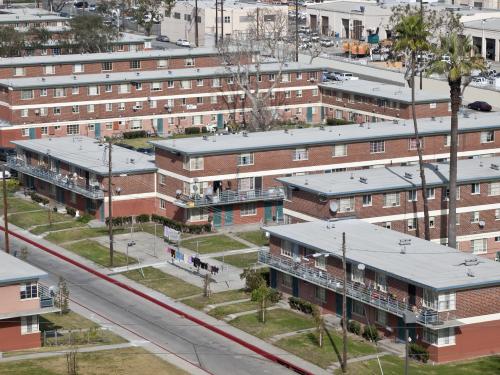Having a safe, stable, healthy place to live is essential. But, for some families, once the rent or mortgage is paid, very little cash remains in the monthly budget. In these instances, households may skimp on other necessities, such as food, clothes, health care, and transportation. If a large share of income is needed to cover rent, unexpected expenses or declines in income – say from reduced working hours – may cause households to fall short on rent, increasing the likelihood of eviction. Stress induced by persistent financial constraints and housing instability reduces people’s ability to make good decisions, and can harm children’s and adults’ physical and emotional health. Moreover, households that struggle to afford immediate necessities will find it nearly impossible to save money for a rainy day or longer-term investments. In short, when housing costs take up too much of a family’s income, their economic and physical well-being may suffer.
Whether a family is spending “too much” on housing is a somewhat subjective assessment. The U.S. Department of Housing and Urban Development (HUD) defines households that spend more than 30 percent of their income on housing as “cost burdened,” while expenditures of more than 50 percent constitute “severe” cost burdens. But, this standard overlooks the fact that households may have different preferences over how they spend their money and what they purchase. For instance, families may select more expensive housing near their work in order to reduce their commute. Families with children might be willing to pay higher rents in order to live in a better school district. An alternative indicator of whether housing costs may harm a family’s economic well-being is to assess whether their income remaining after paying rent is sufficient to purchase other necessities.
An alternative indicator of whether housing costs may harm a family’s economic well-being is to assess whether their income remaining after paying rent is sufficient to purchase other necessities.
In a recent analysis,[1] we used two measures – rent-to-income ratios and income remaining after rent (“residual income”) – to assess whether housing costs are creating economic distress for low-income renters. Using household-level data from the 2015 American Community Survey, we calculated rent-to-income ratios and residual income for all renter households. We analyzed differences in rent burdens for households of different income levels, focusing particularly on families in the lowest 20 percent of the income distribution. The typical low-income renter faces severe rent burden, and this rent burden has grown substantially over the past 15 years. Additionally, severe rent burdens are not constrained to large cities, as low income renters in all geographies are facing these challenges.
Low-income households are stretching to pay the rent, and still afford other necessities
Low-income renters in the U.S. face acute problems balancing the cost of housing and paying for other necessary expenses. Among families in the bottom 20 percent of income, the median renter pays more than half of its monthly income on rent, and has less than $500 per month remaining after rent (Figure 1).

To assess whether income after rent will cover a household’s other necessities, we compare the residual incomes to the Census Bureau’s Supplemental Poverty Measure (SPM). This is an extension of the official federal poverty definition that compares a family’s income to the amount needed to afford housing, food, and other essential expenses in their local area. In 2015, the SPM estimated that a family of four on the border of poverty would have needed just under $1400 per month to cover non-housing expenses. The median monthly income after rent for the lowest-income renters is only one third of this amount (Table 1). The median renter in the second income quintile has income left after rent that is 140 percent of the non-housing part of the SPM.

Despite media attention to the rising costs of housing in many parts of the country, we find little evidence that households above the lowest income tier face high rent burdens, using either the rent-to-income measure or the residual income standard. In part, this is because rents do not rise proportionally with income. The lowest income renters pay about half the median rent of the highest income renters, but earn only 10 percent of their income.
Although renters in the bottom quintile appear particularly rent burdened, tax credits, rental assistance, and other in-kind benefits mitigate some of the burden. This assistance is typically not captured in our data. For example, in 2015 a low-income couple with two children whose wage income is at the median of the bottom quintile would qualify for an earned income tax credit (EITC) of nearly $5,000 annually and may also be eligible for Supplemental Nutrition Assistance Program (SNAP) benefits of up to $4,000 per year. These benefits are available to a lesser degree to households in the 2nd income quintile and are phased out for most households in the 3rd quintile or above.
Rent burdens are getting worse, as rents rise and incomes decline
The share of income spent on rent has increased substantially since 2000. In 2015 the median renter in the bottom quintile of the income distribution spent 11 percentage points more of their income on rent than they did 15 years earlier in 2000 (Figure 2). This increase in rent burdens occurred through each business cycle period including the period prior to the financial crisis (2000-2006), the economic downturn (2006-2009), and the subsequent recovery (2009-2015). Although rent-to-income levels are greatest among low-income households, the share of income spent on rent also rose among higher income renters, with increased ratios for all income quintiles.

The increased rental burden for low income households since 2000 came not just from rising rents, but also from a decline in real incomes (Figure 3). While the median monthly rent of low-income renters increased by $60, median monthly incomes fell by just over $100. These renters are therefore getting squeezed by both declining incomes and rising rents, and finding that there is less money remaining for other expenses as a result.

It’s not just NYC and San Francisco: renters in small towns and rural areas are squeezed too
Low-income renters in large cities, mid-sized cities, and rural areas face similarly high cost burdens and low residual incomes (Table 2). Rent-to-income ratios for low-income renters are highest within metropolitan areas and lowest in rural areas, but all are above HUD’s 30 percent cost burden threshold, and all have residual incomes well below the threshold suggested by the SPM. This is true irrespective of where individuals live in the country.

Current housing policies are not well designed to address poor families’ housing needs
Low-income renters face challenges paying for housing and covering other necessities. The high rent-to-income ratios and limited residual income we have documented could harm the economic stability and well-being of many low-income families. Several features of current housing policies could be changed to better support low-income families.
- Make federal housing assistance an entitlement, not a lottery.
Unlike policies such as food stamps and Medicaid, housing assistance is not an entitlement for low-income families. Eligible families often wait for many years on a waiting list to receive Housing Choice Vouchers or apartments in public housing. Fewer than one in four eligible families receive federal help. Even without increasing the amount of resources, programs could be restructured to serve more families with smaller per-family grants.
- Cut housing subsidies to wealthy homeowners, increase subsidies to poor renters.
Nearly 60 percent of the lowest-income families are renters. But by far the largest housing subsidy in the U.S. – the mortgage interest deduction – is targeted to homeowners, and benefits wealthy homeowners the most. A progressive, revenue-neutral approach to tax reform could reduce the mortgage interest deduction and use the savings to expand Housing Choice Vouchers. (Just for comparison, capping the mortgage interest deduction to offset eliminating the estate tax doesn’t actually help poor families that much.)
- Maintain and expand income supports for low-income families.
For the lowest income renters, housing cost burdens are primarily caused by low incomes. Applying HUD’s 30 percent standard implies that renters in the lowest income quintile can only afford to spend $310 per month on rent – well below operating costs for even a modest market rate apartment in most of the U.S. The decline in cash income for the bottom quintile over the past 15 years exacerbates this challenge. The most direct policy solution is thus to maintain the income supplement programs which have filled the gap for many renters, and provide targeted expansions of successful programs, such as the EITC. Income supports typically have lower administrative costs than many supply side housing programs, such as the Low Income Housing Tax Credit, and can be implemented more quickly than developing new housing. They also reflect the reality that addressing rental affordability among low-income renters also requires addressing the broader financial challenges these families experience.
[1] Thanks to my co-author Jeff Larrimore for his contributions on the longer version of this analysis. The opinions and conclusions expressed here are solely my own and do not indicate concurrence by the Board of Governors of the Federal Reserve System.
Cover photo by Loren Kerns/Flickr.
The Brookings Institution is committed to quality, independence, and impact.
We are supported by a diverse array of funders. In line with our values and policies, each Brookings publication represents the sole views of its author(s).







Commentary
Is the rent “too damn high”? Or are incomes too low?
December 19, 2017